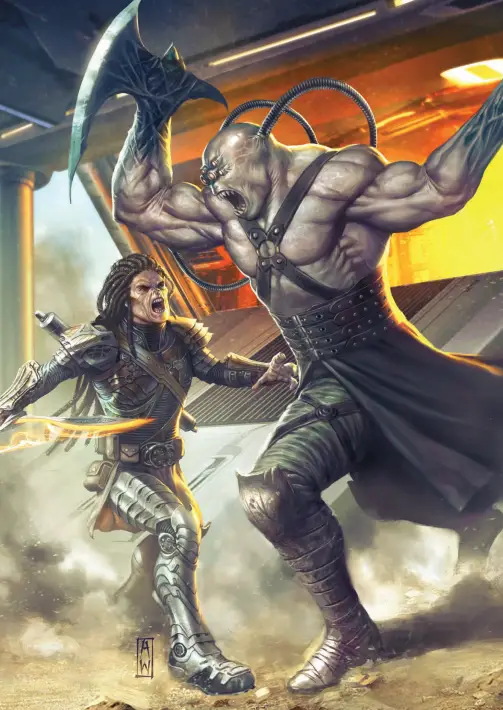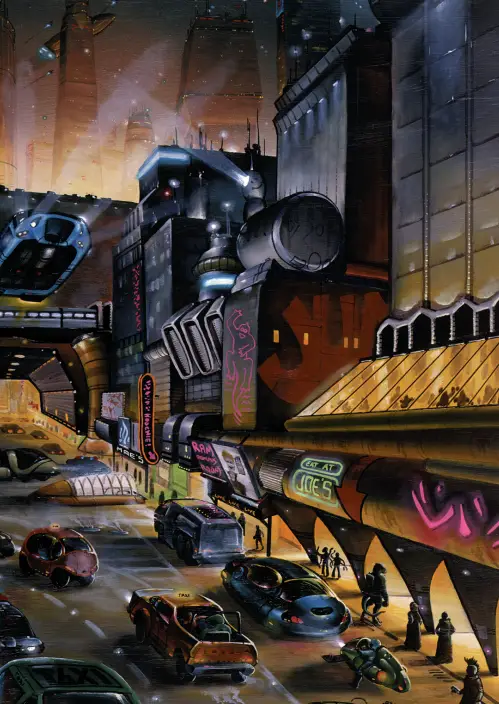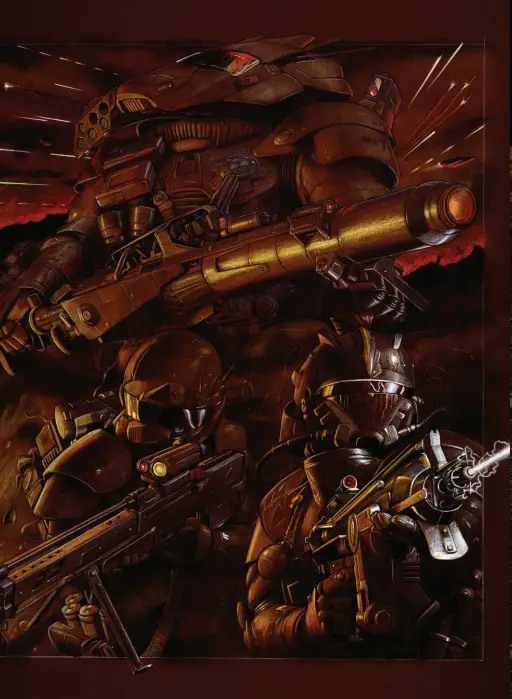The good folks over at 23rd Century Productions have sent us over a copy of the 7th edition of Battlelords of the 23rd Century, so why don’t we crack the hard shell plating on this big one open and see what gooey bits we can find inside.
To battle!
Let’s not beat around the bush here. Battlelords is a game about combat. It’s named after the in-universe title of “battlelord”: members of the galactic military outside of the chain of command and that have an extensive remit to deal with whatever problem they encounter, preferably with force. Your characters aspire to become one of them, and there’s a lot of shooting to be done on the way. Yeah, you can do other things except for fighting, but that’s not really the aim here. There are many rules in this game, and most of them are designed with combat in mind. If a mechanics heavy, sci-fi combat simulator doesn’t interest you, then you can stop reading now. For those of you that think that this sounds neat, onwards! Once more into the breach, my friends!

A not so distant future, in a galaxy, …that is actually this one
It’s the year 2282, just over 250 years into the future, and the human race has definitely expanded its horizons. They are now part of the Galactic Alliance. This organization spans the Milky Way, whose main goal seems to be to help defend its member species from outside threats. Principal among whom are the Arachnid hordes (most of which don’t look all that much like spiders) and the Atlantean nanite swarms (which do look like they’re made of nanites).
As citizens of this alliance, you’ll be choosing from one of 16 species (well, technically 14, and 2 more sub-species). There is an agreeable amount of physical difference between them all, providing plenty of options. Most are bipedal humanoids; however, the cat-like Cizerack often move on all-fours, while the Raazet are winged. They are also insects, while the Python Lizards (and their cousins, the Ram Pythons) are lizardlike. The Keen are a bat-like species that can glide and change colour, while the Fotts are genetically created rabbit-people, and the Eridani are Orcs-in-Space (but with none of the usual chaotic, destructive nature)! Some others have special powers due to their biology, like the Zen Rigeln that use their ability to manipulate organic matter to heal, or the empathetic Chatilians.
While all these species are pretty cool and add plenty of diversity to the universe, which is vital to make it feel more otherworldly, there is also a “planet of hats” problem. The Eridani are all rigidly militaristic, and the Orions are tricksters and like to party, for example. While a lot of effort has been made to make these species genetically different to each other, unfortunately, they all end up looking like cultural monoliths inside an even larger cultural monolith that is the alliance itself. Entire branches of galactic governance seem to be dominated by one race, with the police and Galactic Marine Corps (should they still be called marines in space?) being made up of Python Lizards or the military being dominated by the Eridani.

As a general rule, the setting feels pretty thin, which is where most of the problems come from. It’s one of those cases where there is a lot to cover and just not enough time and space to do it. The internal workings of a galactic alliance made up of 16 species requires a lot of work to flesh out properly, and Battlelords doesn’t dedicate the necessary efforts to flesh it out. We get a few paragraphs to understand its entire system of law and governance, for example. We’ll come back to why this can make things difficult later, but it’s pretty evident that worldbuilding and lore came second in design priorities compared to our next topic: the game’s mechanics.
Crunchy rules, with optional extra crunch
Battlelords uses a percentile “roll under” system. You roll a d100, and you try to roll under a target percentage, determined by your vital statistics and skill levels. For example, the target percentage for a Lip Reading Skill Check is determined by your IQ (the linked vital statistic) and your skill at lipreading. The actual calculation works out at Linked Statistic / 2 +5% per level of skill. For reference, you can have a maximum of 3 levels in a skill and a vital statistic maximum of 150. So if you have 2 levels of Lip Reading and an IQ of 60, then the target number is 60 / 2 + 2*5%, which works out at 40.
That might seem like a lot of maths every time you need to make a roll, but you’ll be calculating all of these percentages on your character sheet (which, to its credit, does a pretty good job at trying to keep information organized), so it’s generally just a case of referencing the correct box when needed.
However, that’s only where the fun starts. Remember at the start when I said that it was mechanics heavy? Well, that simple skill check rule has many variables that can be added on and that you need to keep in mind. For example, that formula works when making a skill check, but what happens if none of the 100 or so skills in the game is suited? Well, in that case, you make a Vital Statistics check, which is simply roll under your vital statistic. Pretty easy, but it’s one extra thing to keep in mind (also, this isn’t the same as doing a skill check with a skill you don’t know, in which case you have to roll under your linked statistic / 2).
But what check should you be making? Well, there are 8 Vital Statistics, including some easily recognizable from other TTRPGs (like Strength, Charisma and Constitution), others that you can probably quickly imagine what they correspond to (IQ, Manual Dexterity, and Agility), and finally others that are slightly rarer (Intuition, which is all about awareness, instincts, but also perception, and Aggression, which is about keeping your calm).
These vital statistics also have “sub-statistics” that come from them. Your agility will also determine your dodge and your initiative modifier, Strength determines Encumbrance and damage modifiers with melee weapons, while Intuition might help with determining your “Mental Environmental Condition Rolls” (such as resisting mental attacks). That’s, of course, without getting into the about 100 skills that your character can train in (up to three levels a skill).
If you’re starting to feel like this is all getting to be a bit overwhelming or confusing, then I’m sorry to say that this game might not be for you because we’re only just scratching the surface here.

Combat, fighting, and war
This is where things get in-depth. At its heart, Battlelords is a combat simulator, and it shows. The combat rules cover 43 pages (not including the basic explanation of the mechanics described earlier in the book). A further 94 pages are dedicated to weapons and armour, 51 for other equipment and cybernetics, 56 for vehicles and spacecraft, and 37 for matrices (which is the term used for the more exotic powers such as energy manipulation, organic matter modifying, or empathic abilities). That’s 281 pages dedicated to combat and the different tools used in it.
That’s a lot to get through. If you’re really interested in customizing your character with different weapons, armour, tools and equipment, then this can be cool to go through. The wide variety also means that you can have an additional tactical element, choosing which weapons might bypass an enemy’s armour, or inversely deciding to equip a special mental shielding because you know you’re going up against a foe who has access to mind control abilities. These decisions add considerable depth to the games combat system, which, considering the focus of Battlelords, needs to be engaging for the system to hold any weight with your players.
However, the dark side of all of these extra add ons is information overload and additional complexity. This is a TTRPG that needs your players to be interested in digging into the details and are willing to go through a few hundred pages of rules to make the right choices for their characters. You’re also going to have to keep a lot of plates spinning at once if you want to try and keep play moving forward.
Let’s take the armour rules. Armour has a hard outer plating that a weapon has to get through, then has to get through the softer cushioning layer before finally actually touching the character. These different layers can be repaired and regenerate at different rates and can have other effects. Your armour might also have special resistances to specific effects (flame resistant, or maybe it’s better against energy weapons and weaker against swords). Of course, if that isn’t enough, you might want to add extra bits like energy shields. And all of this is before we talk about the different areas on the body that you might be hit and the rules for that.

All of this complexity is repeated in every area of combat. There are special rules for vehicle combat and space combat and different ways of healing damage and surgery, or for how many actions you have and what you can do with them. The sheer quantity makes it impossible for me to provide even basic details of all the mechanics here without this article running to ridiculous lengths.
The aim is to produce the ultimate combat simulation rules, as accurate as possible to a real fight (or at least, the general cultural impression of what “real” combat is like), and in that aim, it succeeds. There is no doubt that Battlelords is an excellent ruleset for combat simulation, and it should be saluted for that. It does come at the expense of the other aspects of gameplay, however, and while that’s fine if you’re not looking for anything else, as we’ll see in the conclusion, it does go against some of the games own intended ideals.
The face of war
In such a rules-heavy book, aesthetics and presentation are essential to make reading through it palatable. Visually, the book is impressive. It’s got a nice futuristic vibe, with a certain ragged feel that fits well into the games “plucky heroes against the odds” vibe. The artwork is varied, starting with a more “realistic” photo style at the beginning of the book with digitally rendered images before moving to a comic book art style towards the end.
There is plenty of space to break up the blocks of text, which is essential to help relax the eyes and make sure that information is presented clearly. They also don’t skimp on the tables, which is critical given the amount of equipment and rules they help summarize. There is a nice interplay of colours, with a strong theme of simple black and white, occasionally broken up by splashes of red to highlight certain vital extras or special rules.
Unfortunately, the organization of the book isn’t always optimal. It was always going to be an uphill struggle to keep the information clear where there is so much of it to deal with, but some fundamental factors make navigation hard. There is no index at the end, for example. In the long list of skills (about 100 of them, remember), the descriptions have no reminder of the associated statistic, meaning you have to flip back to the table at the start, and the descriptions of the species happen before any of the actual statistics or abbreviations are explained. One of the clearest examples is the section entitled “The Two Most Important Rules”, helpfully located on… page 519. It’s by no means an insurmountable failure in organisation, but it sure doesn’t help.

The Battlelord’s Battle Master
In older editions of the game, the GM was called the Battle Master, and I feel like it’s a bit of a shame that they’ve switched to the more general “Game Master,” as the old term reinforced what the game is about: fighting things. The game provides many different ways to fight and even offers different situations where you might find yourself fighting in the GM section (soldiers, mercenaries, spies, assassins, bounty hunters, pirates,…). It’s built entirely around it (though surprisingly, it provides relatively few examples of things to fight), and it does a great job of achieving that goal.
Where it stumbles (and it is only a stumble), however, is in achieving its other stated goals. The GMing section details the games recurring themes: the grunt in the trenches feel, overcoming racism (or speciesism in this case) and stereotypes, runaway capitalism, and inequality. These are all exciting goals, but the game doesn’t follow up on them in any meaningful way. Difficulties between species are mentioned in the lore. There is a table covering each species’ general views in relation to each other, but the themes of discrimination stop there. Capitalism and inequality can be deduced from the information on salaries and the costs of weapons and armour. There are a couple of ways that these themes sink into the game, but in reality, these are pretty much lost in all the other rules, and it’s left to the GM to try and work these narratives into the story with little mechanical help.
Battlelords is an example of one of those times when it’s clear that you can’t be all things to all people. It is the perfect sci-fi combat simulator for those that find other systems too simplified and is guaranteed to provide an engaging tactical experience for you and your players, but don’t expect anything more than that, and it won’t disappoint you. It’s not that you can’t do other things if you wanted to. It’s just that the system doesn’t care about them compared to what it feels is fun. It’s more than willing to sacrifice deeper world-building, or accessible mechanics, to achieve its ultimate aim of crunchy, strategic combat action.
You can pick up a copy of Battlelords of the 23rd Century on their site or on DriveThruRPG.
Images Courtesy of 23rd Century Productions
Have strong thoughts about this piece you need to share? Or maybe there’s something else on your mind you’re wanting to talk about with fellow Fandomentals? Head on over to our Community server to join in the conversation!

